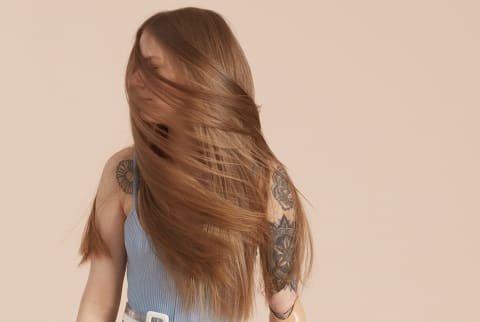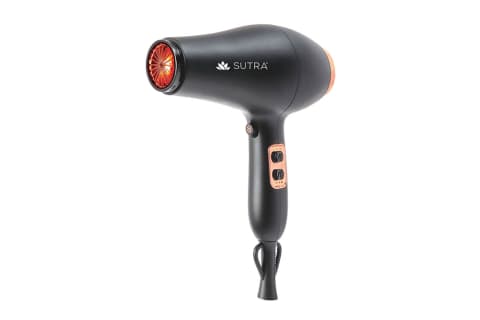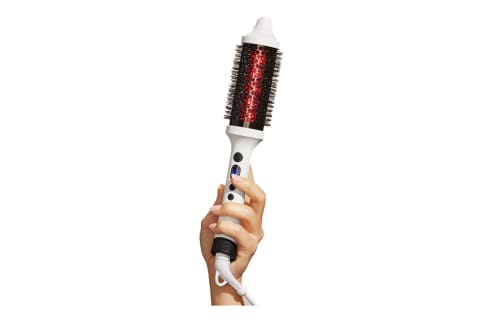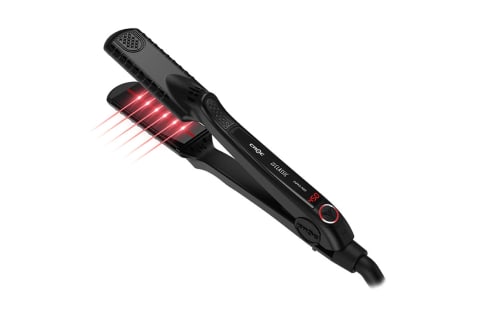Advertisement
So What's The Deal With Infrared Heat Styling? Experts Explain


In beauty circles, everything's coming up infrared. Sauna bathing boasts impressive skin benefits, the best facials incorporate at least a few minutes of LED therapy, and at-home red light devices are becoming more sophisticated every day. It only makes sense that hair care brands want some skin in the game—enter, infrared hot tools.
The healthiest dry is always an air-dry, but these new blow-dryers, flatirons, and thermal brushes promise to mold your strands to your liking while maintaining the integrity of your natural strand pattern and preventing damage.
Now, for the million-dollar question: Do they deliver? I did some digging and consulted trusted experts to find out—here's what you need to know.
What are infrared hot tools?
It turns out, you might have used infrared heat technology without even realizing it. Ceramic and tourmaline-infused styling tools, for example, often generate infrared and far infrared heat while emitting negative ions.
You see, water in hair creates an environment of positive ions, so when these negatively charged tools interact with the strands, they break down those positively charged molecules into smaller compounds that evaporate quicker—thus cutting down on drying time.
"This is a more gentle way for heat application, which results in less frizzy hair because the heat is evenly distributed and penetrates the cuticle deeper," notes Stephanie Angelone, master stylist at RPZL in NYC.
But while ceramic tools are often coated in, well, ceramic, these new infrared devices allow those direct waves to penetrate the hair, which may have specific styling benefits.
Any hair benefits?
Infrared hot tools contain negative ion technology, which again, works with the chemistry of your hair to evaporate water and enhance shine. But the infrared technology penetrate deeper into the strands and heat the hair from within, similar to how infrared heat in general warms our bodies from the inside out. This theoretically leads to a more evenly distributed heat and less damage as a result.
Here's where things get fuzzy. The cortex (aka, the inner layer) of the hair is where your hair holds strength and elasticity, trichologist Kerry Yates, founder of Colour Collective, tells me, so changing that inner structure can still cause damage over time.
It seems that the infrared technology is far gentler on this inner layer, as opposed to traditional tools that blast the cuticle (the super-fragile outer layer) with heat. But damage is damage, and heat harms your hair, no matter how you slice it. Sorry to say, there's no hot tool that completely eliminates the potential for heat damage, infrared options included.
For those with thin, brittle, breakage-prone hair, though, the infrared route may be a better alternative. "Fine hair tends to be delicate, so a more gentle technology will be beneficial in the hair's integrity," Angelone adds.
Infrared hot tools also tend to dry and style the hair faster. "This is especially beneficial for anyone with frizzy hair," says Yates, which requires immediate styling to yield the smoothest results. Not to mention, fewer passes with a flatiron does ultimately mean less damage.
Myth busting common claims
As I mentioned, infrared hot tools do not take damage out of the equation entirely. Heat harms your hair, regardless of the kind. These smarter tools can soften the blow, but you still need to use heat protection (i.e., a mist or leave-in conditioner with hair-protective nutrients) to buffer the strands as they absorb heat. You'll be sure to find a formula you fancy in our roundup here.
You may also wonder if the infrared technology can lead to thicker locks since many hair growth devices rely on the power of LED light therapy. Note: These are two entirely separate avenues.
Yes, it's true that low-level light therapy shows promise for hair growth: One study found that women who received red light therapy at 650 nm every other day for 17 weeks experienced a 51% increase in hair density1, and another research review touted red light therapy as safe and effective for promoting hair growth2 in both men and women.
But infrared blow-dryers, curling wands, and flatirons do not have this same data; and besides, it's not like you're using these hot tools directly on your scalp (ouch). "Infrared hot tools should not be used close to the scalp; therefore, they will have zero benefit to regrowing hair or positively impacting follicle health," declares Yates.
There is an argument to be made that if these tools help maintain the health of your hair, they can help support hair growth in theory. But the infrared heat is meant for your physical hair strands, not the follicles or scalp.
The verdict
Are infrared hot tools healthier for your hair? It's true that these tools gently warm up the hair as opposed to blasting the outer cuticle layer, which is the most fragile part of the strand (especially if you have high porosity hair). But they won't help you evade damage completely—no hot tool can, as a matter of fact.
Who knows—one day we may have some breakthrough technology that can coif your locks to perfection with absolutely zero breakage. But until then, keep your heat-protecting mists handy, even as you shop these elevated infrared tools above.


